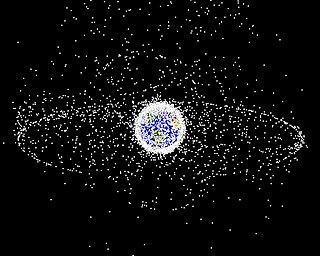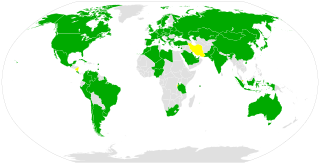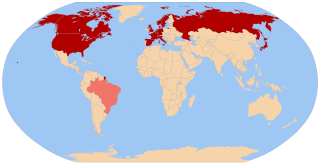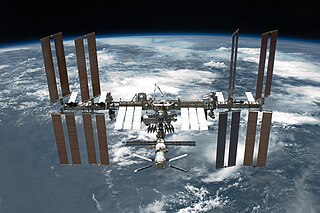Policy by country
United States
United States space policy is drafted by the Executive branch at the direction of the President of the United States, and submitted for approval and establishment of funding to the legislative process of the United States Congress. [20] The President may also negotiate with other nations and sign space treaties on behalf of the US, according to his or her constitutional authority. Congress' final space policy product is, in the case of domestic policy a bill explicitly stating the policy objectives and the budget appropriation for their implementation to be submitted to the President for signature into law, or else a ratified treaty with other nations.
Space advocacy organizations (such as the Space Science Institute, National Space Society, and the Space Generation Advisory Council, learned societies such as the American Astronomical Society and the American Astronautical Society; and policy organizations such as the National Academies) may provide advice to the government and lobby for space goals.
Civilian and scientific space policy is carried out by the National Aeronautics and Space Administration (NASA, subsequent to 29 July 1958), and military space activities (communications, reconnaissance, intelligence, mapping, and missile defense) are carried out by various agencies of the Department of Defense. The President is legally responsible for deciding which space activities fall under the civilian and military areas. [21] In addition, the Department of Commerce's National Oceanic and Atmospheric Administration operates various services with space components, such as the Landsat program. [22]
The President consults with NASA and Department of Defense on their space activity plans, as potential input for the policy draft submitted to Congress. He or she also consults with the National Security Council, the Office of Science and Technology Policy, and the Office of Management and Budget to take into account Congress's expected willingness to provide necessary funding levels for proposed programs. [23]
Once the President's policy draft or treaty is submitted to the Congress, civilian policies are reviewed by the House Subcommittee on Space and Aeronautics and the Senate Subcommittee on Science and Space. These committees also exercise oversight over NASA's operations and investigation of accidents such as the 1967 Apollo 1 fire. Military policies are reviewed and overseen by the House Subcommittee on Strategic Forces and the Senate Subcommittee on Strategic Forces, as well as the House Permanent Select Committee on Intelligence and the Senate Select Committee on Intelligence. The Senate Foreign Relations Committee conducts hearings on proposed space treaties, and the various appropriations committees have power over the budgets for space-related agencies. Space policy efforts are supported by Congressional agencies such as the Congressional Research Service, the Congressional Budget Office, and Government Accountability Office. [24]
History
The early history of United States space policy is linked to the US–Soviet Space Race of the 1960s. The National Aeronautics and Space Act creating NASA was passed in 1958, after the launch of the Soviet Sputnik 1 satellite. Thereafter, in response to the flight of Yuri Gagarin as the first man in space, Kennedy in 1961 committed the United States to landing a man on the Moon by the end of the decade. Although the costs of the Vietnam War and the programs of the Great Society forced cuts to NASA's budget as early as 1965, the first Moon landing occurred in 1969, early in Richard Nixon's presidency. Under the Nixon administration NASA's budget continued to decline and three of the planned Apollo Moon landings were cancelled. The Nixon administration approved the beginning of the Space Shuttle program in 1972, but did not support funding of other projects such as a Mars landing, colonization of the Moon, or a permanent space station. [25]
The Space Shuttle first launched in 1981, during Ronald Reagan's administration. Reagan in 1982 announced a renewed active space effort, which included initiatives such the construction of Space Station Freedom, and the military Strategic Defense Initiative, and, later in his term, a 30 percent increase in NASA's budget. The Space Shuttle Challenger disaster in January 1986 led to a reevaluation of the future of the national space program in the National Commission on Space report and the Ride Report. [25]
The United States has participated in the International Space Station beginning in the 1990s, the Space Shuttle program has continued, although the Space Shuttle Columbia disaster has led to the planned retirement of the Space Shuttle in mid-2011. There is a current debate on the post-Space Shuttle future of the civilian space program: the Constellation program of the George W. Bush administration directed NASA to create a set of new spacecraft with the goal of sending astronauts to the Moon and Mars, [26] but the Obama administration cancelled the Constellation program, opting instead to emphasize development of commercial rocket systems.
The Vision for Space Exploration established under the George W. Bush administration in 2004 was replaced with a new policy released by Barack Obama on 28 June 2010. [27]
In recent years, U.S. space operators and decisionmakers have become increasingly concerned about threats to U.S. space leadership. In the civil sector, this has been driven largely by U.S. dependence on Russia for crew access to the International Space Station (ISS) since the termination of the Space Shuttle program in 2011. In national security, foreign development of counterspace systems has become a regular feature of public statements by U.S. defense and intelligence officials. [28] This is reminiscent of similar concerns about the Soviet Union’s space program between the launch of Sputnik 1 in 1957 and the success of the Apollo lunar missions. The threat of Soviet dominance in space turned out to be less formidable than expected, but it continued to drive policy and programmatic decisions for decades, until the Soviet Union ceased to exist. [29]
Europe
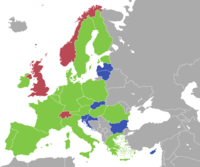
The European Space Agency (ESA) is the common space agency for many European nations. It is independent of the European Union, though the 2007 European Space Policy provides a framework for coordination between the two organizations and member states, including issues such as security and defence, access to space, space science, and space exploration. [30]
The ESA was founded to serve as a counterweight to the dominant United States and Soviet space programs, and further the economic and military independence of Europe. This has included the development of the Ariane rockets, which by 1985 had captured over 40 percent of commercial launch market in the free world. The ESA budget is split between mandatory and voluntary programs, the latter of which allow individual member nations to pursue their own national space goals within the organization. [31]
The ESA Director General's Proposal for the European Space Policy states, "Space systems are strategic assets demonstrating independence and the readiness to assume global responsibilities. Initially developed as defence or scientific projects, they now also provide commercial infrastructures on which important sectors of the economy depend and which are relevant in the daily life of citizens.... Europe needs an effective space policy to enable it to exert global leadership in selected policy areas in accordance with European interests and values." [32]
In the final part of 2010s the ESA has made strong efforts in order to make Europe stronger in the competition for the development of new strategies regarding space policy. Those included a huge increase in ESA's budget promoted by countries such as Italy, France and Germany. [33]
China
Although Chairman Mao Zedong planned after Russia's Sputnik 1 launch to place a Chinese satellite in orbit by 1959 to celebrate the 10th anniversary of the founding of the People's Republic of China (PRC), [34] China did not successfully launch its first satellite until 24 April 1970. Mao and Zhou Enlai decided on 14 July 1967 that the PRC should not be left behind, and started China's own human spaceflight program. [35] The first success came on 15 October 2003 when China sent its first astronaut into space for 21 hours aboard Shenzhou 5.
The Ministry of Aerospace Industry was responsible for the Chinese space program prior to July 1999, when it was split into the China National Space Administration responsible for setting policy, and the state-owned China Aerospace Science and Technology Corporation, responsible for implementation.
The China National Space Administration states its aims as maintaining the country's overall development strategy, making innovations in an independent and self-reliant manner, promoting the country's science and technology sector and encouraging economic and social development, and actively engaging in international cooperation. [36]
Russia and Ukraine
Russia inherited its space programs in 1991 from its predecessor state, the Soviet Union. Russia's civilian space agency is the Russian Federal Space Agency and its military counterpart is the Russian Aerospace Defence Forces. Ukraine's agency is the State Space Agency of Ukraine, which handles both civilian and military programs.
The Soviet Union became the world's first spacefaring state by launching its first satellite, Sputnik 1, on 4 October 1957. The Soviet space program was active from 1955 until the dissolution of the Soviet Union in 1991.
In the 1980s the Soviet Union was considered to be technologically behind the United States, but it outspent the United States in its space budget, and its cosmonauts had spent three times as many days in space as American astronauts. The Soviet Union had also been more willing than the United States to embark on long-term programs, such as the Salyut and Mir space station programs, and increased their investment in space programs throughout the 1970s and 1980s. [37]
After the dissolution of the Soviet Union, the 1990s saw serious financial problems because of the decreased cash flow, which encouraged Roskosmos to improvise and seek other ways to keep space programs running. This resulted in Roskosmos' leading role in commercial satellite launches and space tourism. While scientific missions, such as interplanetary probes or astronomy missions during these years played a very small role, although Roskosmos has connections with Russian aerospace forces, its budget is not part of the defense budget of the country, Roskosmos managed to operate the space station Mir well past its planned lifespan, contribute to the International Space Station, and continue to fly additional Soyuz and Progress missions. [38]
The Russian economy boomed throughout 2005 from high prices for exports, such as oil and gas, and the outlook for subsequent funding became more favorable. The federal space budget for the year 2009 was left unchanged despite the global economic crisis, standing at around 82 billion rubles ($2.4 billion). Current priorities of the Russian space program include the new Angara rocket family and development of new communications, navigation and remote Earth sensing spacecraft. The GLONASS global navigation satellite system has for many years been one of the top priorities and has been given its own budget line in the federal space budget.[ citation needed ]
India
The purpose of India's space program was outlined[ when? ] by Vikram Sarabhai (regarded as the father of the Indian space program): [39]
There are some who question the relevance of space activities in a developing nation. To us, there is no ambiguity of purpose....we are convinced that if we are to play a meaningful role nationally, and in the community of nations, we must be second to none in the application of advanced technologies to the real problems of man and society.
The Department of Space (DoS) is the Indian government department responsible for administration of the Indian space program. It manages several agencies and institutes related to space exploration and space technologies. The Indian space program under the DoS aims to promote the development and application of space science and technology for the socio-economic benefit of the country. It includes two major satellite systems, INSAT for communication, television broadcasting and meteorological services, and Indian Remote Sensing Satellites (IRS) system for resources monitoring and management. It has also developed two satellite launch vehicles, Polar Satellite Launch Vehicle (PSLV) and Geosynchronous Satellite Launch Vehicle (GSLV), to place IRS and INSAT class satellites in orbit.



